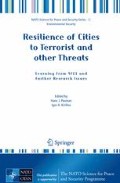Abstract
Increase of economic activity, population density, choke points by multiple use of space, traffic nodes (mega-storey) high-rises etc. make our society more vulnerable. At the same time, there is a trend of increase in safety standard with political consequences. A disaster plan shall be ready and the mayor of a city is held responsible. It calls for a new multidisciplinary approach of emergency and disaster response planning coping with a wide variety of threats. It starts with the dilemma, in particular for political leadership, of where to draw the line of ‘how safe is safe enough.’ This depends on ambition of governance, risk profile of the region, policy of what shall be the capacity of emergency and disaster response forces versus the industry effort in protection and that of the public itself. Land use planning and licensing of industrial and building activity are keys for timely preparation. Risk analysis is used for years as a basis for decision making despite the uncertainty in underlying models. For the new task, however, not only space but also explicit time resolved scenario analysis has to be introduced since time is in response effectiveness a crucial parameter. The paper will describe a possible way ahead to help stakeholders to reach their goal, and the various tools, models and data needed. In the complexity of modern urban area and associated organizational structure scenario analysis once fully developed can become a major tool for improving resilience.
Access this chapter
Tax calculation will be finalised at checkout
Purchases are for personal use only
Preview
Unable to display preview. Download preview PDF.
References
Boot, H., Van het Veld, F., and Kootstra, F., 2006, Riskcurves: A Comprehensive Program Package for Performing a Quantitative Risk Assessment, http://aiche. confex.com/aiche/s06/preliminaryprogram/abstract_41576.htm.
Butler, A.S., Pantzer, A.M., and Goldfrank, L.R. (eds.), 2003, Committee on respon-ding to the psychological consequences of terrorism, Board on neuroscience and behavioral health: Preparing for the psychological consequences of terrorism; a public health strategy. National Academies Press, Washington DC.
Center for Chemical Process Safety of the American Institute of Chemical Engineers, 2001, Layer of Protection Analysis: Simplified Process Risk Assessment, Guide-line CCPS—AIChE, New York, ISBN 0-8169-0811-7.
Committee for the Prevention of Disasters (CPR), 1997, Methods for Calculating the Physical Effects of Incidental Discharges of Hazardous Materials (liquids and gases) (the “Yellow Book”, now also known as PGS#2), CPR 14E, 3rd ed., Parts 1 and 2, ISSN: 0921-9633/2.10.014/9110, also see TNO Safety Software EFFECTS, DAMAGE, EFFECTS PLUS, EFFECTS GIS, Version 5.5, © 2003, TNO, e-mail: EFFECTS@mep.tno.nl.
Committee for the Prevention of Disasters (CPR), 1989, Methods for the Dete-rmination of Possible Damage to People and Objects Resulting from Releases of Hazardous Materials (the “Green Book”), CPR 16E, December (Dutch edition ISBN 90-5307-052-4, now known as PGS#1), see same as for Yellow Book. DiNenno P.J. et al. (eds.), 2002, the SFPE Handbook of Fire Protection Engineering, NFPA, Quincy, MA, 3rd ed.
Haddon, W.A. Jr., 1972, A logical framework for categorizing highway safety phenomena and activity. Journal of Trauma, 12(3):193-207.
Holder, Y., Peder, M., Krug, E., Lund, J., Gururaj, G., Kobusingye, O. (eds.), 2001, Injury Surveillance Guidelines. WHO, Geneva.
Jonkman, S.N., 2007, Loss of Life Estimation in Flood Risk Assessment, Dissertation, Technical University of Delft, The Netherlands.
Kuligowski, E.D., and Peacock, R.D., 2005, Review of building evacuation models, NIST Technical Note 1471.
PARC C3.3, WG2, 2006, Risk analysis for road tunnels, final draft, March 2006.
Purser D.A., 2000, Toxic product yields and hazard assessment for fully enclosed design fires, Polymer International, 49:1232-1255.
Railtrack, 2000, Yellow Book 3, vol. 2, Engineering Safety Management Guidance, Praxis, Bath, UK.
Salvi, O., and Debray, B., 2006, A global view on ARAMIS, a risk assessment methodology for industries in the framework of the SEVESO II directive, Journal of Hazardous Materials, 130:187-199.
Sundnes K.O., and Birnbaum M.L., 2003, Health disaster management guidelines for evaluation and research in the Utstein style, Prehospital and Disaster Medicine, 17, supplement 2. Vol I, Ch. 2: Current methods used for evaluation and research, p. 25-30.
Author information
Authors and Affiliations
Corresponding author
Editor information
Editors and Affiliations
Rights and permissions
Copyright information
© 2008 Springer Science + Business Media B.V
About this paper
Cite this paper
van der Torn, P., Pasman, H.J. (2008). How to Plan for Emergency and Disaster Response Operations in View of Structural Risk Reduction. In: Pasman, H.J., Kirillov, I.A. (eds) Resilience of Cities to Terrorist and other Threats. NATO Science for Peace and Security Series Series C: Environmental Security. Springer, Dordrecht. https://doi.org/10.1007/978-1-4020-8489-8_17
Download citation
DOI: https://doi.org/10.1007/978-1-4020-8489-8_17
Publisher Name: Springer, Dordrecht
Print ISBN: 978-1-4020-8488-1
Online ISBN: 978-1-4020-8489-8
eBook Packages: Architecture and DesignEngineering (R0)

